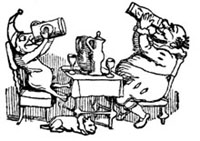
Teacher Preparation in Catholic Colleges
MISSING THE BOAT
Public education in America is in free-fall; and education in many diocesan Catholic schools needlessly sufferers from many of the same maladies, compounded by serious financial problems and epicene catechetics. Catholic higher education, even in the clearly orthodox colleges, is doing little or nothing to remedy the situations. But, dear reader, despair not: there are several things that can be done.
Many educational disasters either struck the public-school system from without or were inadvertently welcomed from within. Multiculturalism mutated from a wholesome appreciation of foreign cultures to the notion that all cultures are equal, such that fourth-rate scribblings by minority authors were equated with the classics of Western civilization. Education of the gifted, which should have demonstrated the best methods of educating our future leaders, instead took the form of either pulling out the able from regular classes two hours per week so that they could make pottery, or leaving them in those classes so they could help teach the others. Modern theories of child development, especially when adopted at the campus or district levels, discouraged teachers from challenging many younger pupils. Faulty progressive educational theories — many of them originating centuries ago — metastasized in collegiate departments of education during the 1960s: Rousseauvianism (man is basically good, there is no original sin, evil exists only in man-made institutions, etc.); the beliefs of Dewey (an atheist and socialist) and his whelps; the over-emphasis on self-esteem, moral relativism, and deconstructionism. Radical feminism took its toll, too, erasing the very concepts of “masculine” and “feminine.”
There was more. When the obvious decline in learning was clearly documented by lower SAT scores, the College Board wilted under the pressure and in 1996 re-normed their test, essentially bumping up the mean score by about 80 points. If Major League Baseball responded to complaints that not enough home runs were being hit, and, accordingly, moved in all the outfield fences by 80 feet, the result would have been the same. The teaching “profession” adopted the anti-merit pay scale, refusing to accommodate any supply/demand difference between kindergarten teachers and physics teachers, or any differences at all in competence among all teachers: older must mean better. The tenure system made it either impossible or very costly to dismiss any instructor. And the notorious National Education Association, with its far-left educational, political, and social agenda (pro-abortion, sex-education, and “gay rights”; anti-religion and school vouchers, etc.) controls most teachers through its often mandatory union membership requirements.
By far, the most damage to the public-school system during the 20th century came from court decisions. A barrage of Supreme Court mandates chipped away at educators’ authority, all but eliminating their once-prevalent in loco parentis status, and thereby destroying the basis for school discipline. No longer was the teacher’s word taken as final and accordingly supported by parents at home. Instead, lawsuits proliferated, and teachers became adversaries of parents, with helpless administrators scurrying for cover. The other category of court decisions was even more lethal, although seldom recognized as such: church-state relations. More enlightened constitutional scholars know that the Founders’ original intent of the First Amendment was simply to assure that there was not to be an official Church of America like that in England. What began as the banning of Bible reading — actually welcomed by many Catholics at the time, since the readings were from that dangerous King James version — ended with the acceptance of a mythical “wall” of separation that purged from public schools not only overtly religious instruction and worship but also all moral instruction that smelled of religion. No longer could a teacher provide any moral or religious basis for, say, cheating on a test. The resulting secularization even extended to the character of teachers. “Proper role model,” a term almost universally understood and accepted in the 1950s, became unpalatable, its use even considered a form of bigotry. Openly promiscuous and/or homosexual teachers could no longer be censured, let alone dismissed, as long as their after-school conduct did not occur during working hours.
You May Also Enjoy
Cynics will object that students at orthodox Catholic colleges become inflexible and excessively dogmatic, but the real intolerance and bigotry occurs everywhere else.
Catholic schools embrace a mission that is illegal in public schools: the embodiment of Jesus Christ in the faculty, staff, students, and their parents.
A saint is one who sees, who sees his relationship not only to family members, classmates, and business associates but to the entire Mystical Body.

